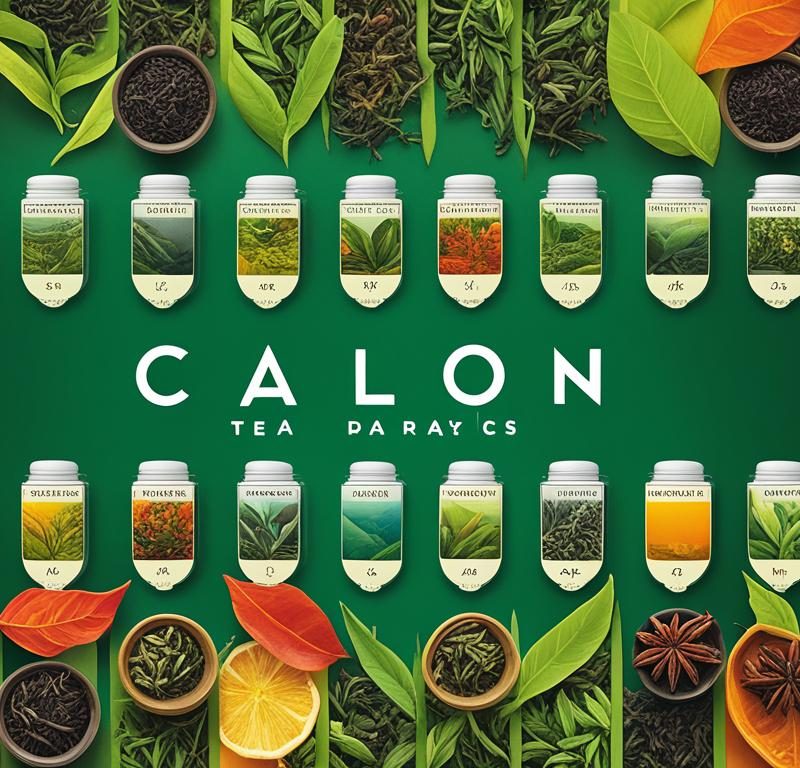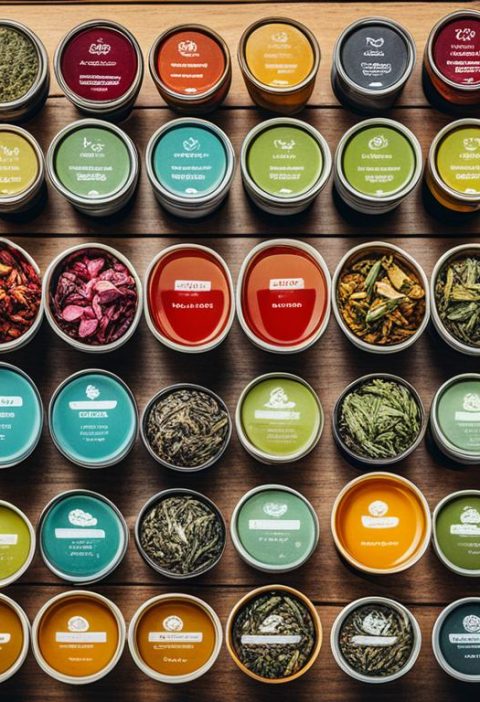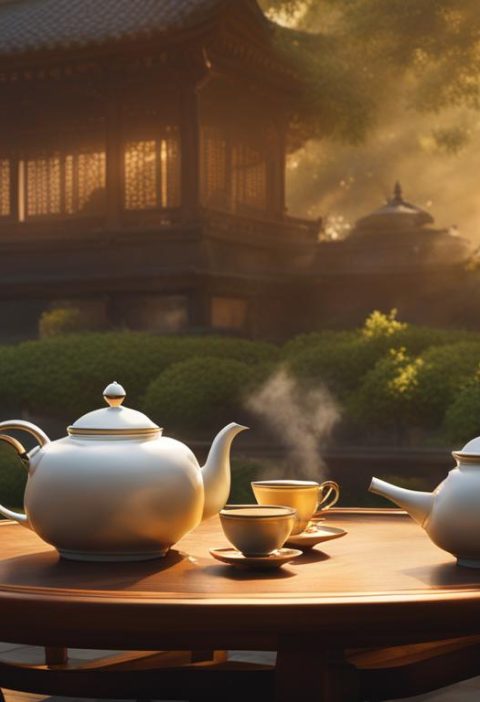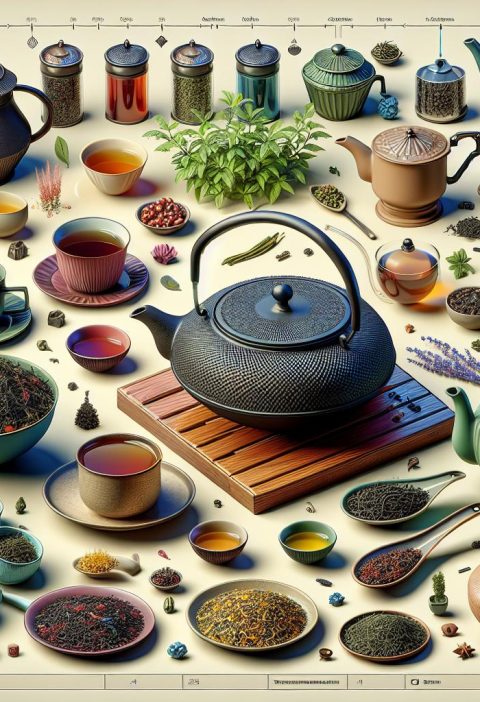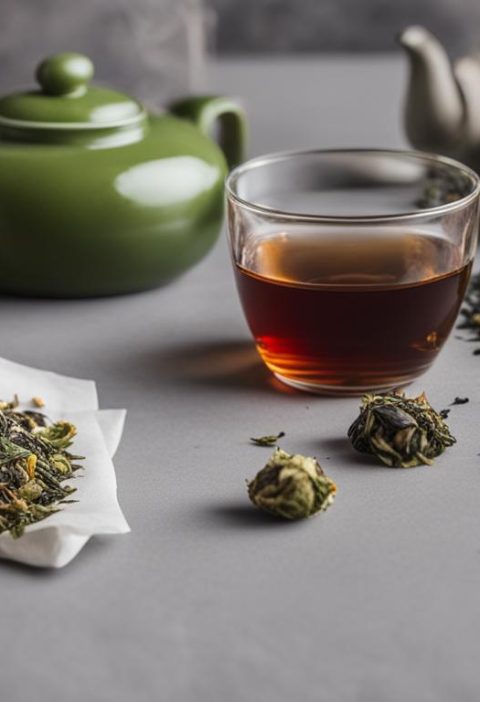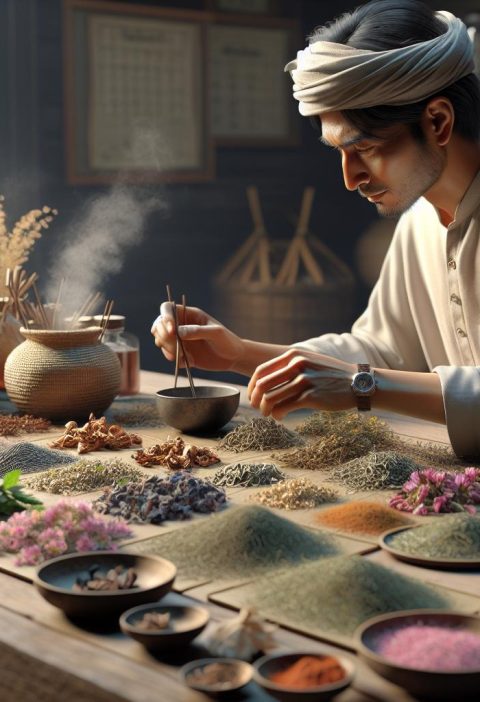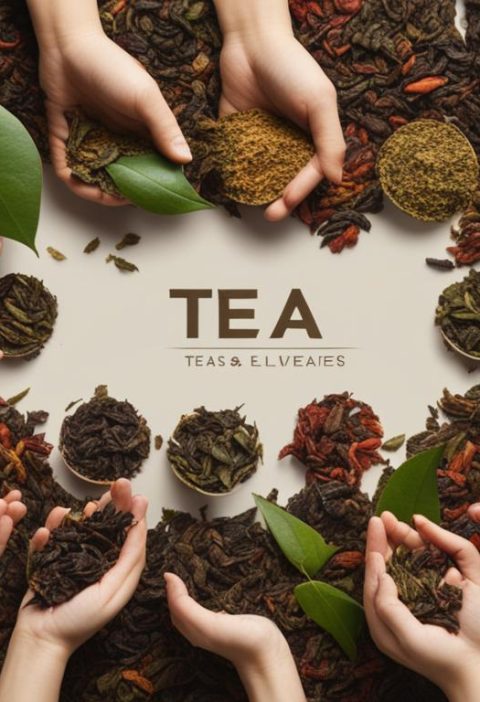Sri Lanka, formerly known as Ceylon, is renowned for its diverse range of tea varieties. The country’s unique geography, climate, and cultivation practices contribute to the aromatic profiles of Ceylon teas, making them highly sought after by tea enthusiasts worldwide. From the crisp and floral flavors of teas grown in Nuwara Eliya to the robust and full-bodied teas from Ruhuna, each region offers distinctive aromas and characteristics. The grading system for Ceylon tea allows consumers to choose teas based on their preferred flavor profiles, ranging from delicate and nuanced to bold and robust. Let’s dive deeper into the fascinating world of the aromatic profiles of Ceylon tea varieties.
Key Takeaways:
- Ceylon tea varieties have distinct aromatic profiles influenced by Sri Lanka’s geography, climate, and cultivation practices.
- The grading system of Ceylon tea helps consumers choose teas based on their preferred flavor profiles.
- Ceylon tea regions like Nuwara Eliya and Ruhuna offer unique aromas and characteristics.
- The diverse landscapes of Sri Lanka contribute to the varied aromatics in Ceylon teas.
- Exploring the aromatic profiles of Ceylon tea varieties enhances the tea-drinking experience.
The Birth of Ceylon Tea
Ceylon tea has a fascinating history that dates back to the mid-19th century. It all began when the British colonizers introduced tea cultivation to Sri Lanka, then known as Ceylon. The unique climate and fertile soils of the island, combined with its varied altitudes, created the perfect conditions for growing tea. With their expertise, the colonizers transformed Ceylon into one of the world’s most remarkable tea-producing regions.
Sri Lanka’s diverse landscapes, ranging from rugged terrains to lush valleys and soaring mountains, contribute to the distinctive flavors and aromas found in Ceylon tea. The tea bushes thrive in these ideal natural settings, taking advantage of the island’s unique climate and fertile soils. The different altitudes at which tea is grown further contribute to the aromatic profiles of the tea, resulting in a wide range of flavors and characteristics.
Tea Cultivation in Sri Lanka
Tea cultivation in Sri Lanka began when James Taylor, a British planter, established the first commercial tea plantation in the area now known as Kandy. Taylor’s success paved the way for the growth of the tea industry in Ceylon, and plantations started to spread across the island. Today, Sri Lanka is renowned for its high-quality teas and is one of the largest tea-producing countries in the world.
| Key Factors | Impact on Tea |
|---|---|
| Unique Climate | The climate of Sri Lanka, with its distinct wet and dry seasons, contributes to the development of complex flavors in Ceylon tea. |
| Fertile Soils | The fertile soils of Sri Lanka provide essential nutrients and minerals for tea bushes, resulting in healthy plants and flavorful tea leaves. |
| Altitude | The different altitudes at which tea is grown in Sri Lanka contribute to the varying flavors and aromas found in Ceylon tea. |
The unique combination of the island’s climate, fertile soils, and varying altitudes creates the perfect environment for the cultivation of Ceylon tea. These factors, coupled with the expertise brought by the British colonizers, have shaped the exceptional tea industry in Sri Lanka. The birth of Ceylon tea marks the beginning of a tea legacy that continues to enchant tea lovers around the world.
Geography and Climate: Factors Influencing Ceylon’s Tea Taste
The geography and climate of Sri Lanka greatly contribute to the unique and diverse taste of Ceylon tea. The country’s varied landscapes, encompassing rugged terrains, lush valleys, and majestic mountains, create micro-climates that give rise to distinct flavors and aromas in the tea.
The altitude at which tea is grown is a crucial factor in determining its taste. Higher elevations result in teas with brisk and bright characteristics, often accompanied by delicate floral and citrusy notes. On the other hand, teas grown at lower altitudes possess a bolder and fuller flavor profile. This interplay between altitude and tea taste adds to the complexity and appeal of Ceylon tea.
The temperature fluctuations experienced in different regions further contribute to the unique flavor development in Ceylon tea. These temperature changes affect the biochemical processes that occur within the tea leaves, ultimately shaping the taste and aroma of the final product.
Additionally, the soil conditions across Sri Lanka vary from region to region, impacting the overall quality of the tea. The composition and fertility of the soil influence the tea plants’ ability to absorb essential nutrients, which in turn affects the flavor and character of the tea. The diverse soil conditions in Sri Lanka contribute to the wide range of flavors found in Ceylon teas.
Micro-climates and Tea Taste
The micro-climates created by the unique geography and climate of Sri Lanka further enhance the complexity of Ceylon tea. Each tea growing region has its own distinct micro-climate, characterized by variations in rainfall, humidity, and temperature. These micro-climates play a significant role in shaping the specific flavors and aromas found in teas from different regions.
For example, the cool and misty conditions of Nuwara Eliya, located at the highest altitudes, contribute to the production of teas with delicate and nuanced flavors. The brisk winds and low temperatures result in teas with unique floral and fruity notes. In contrast, the warmer and humid micro-climates found in regions like Ruhuna yield teas with stronger and bolder profiles, often exhibiting earthy undertones.
These micro-climates, combined with the other geographical and climatic factors, work in harmony to create the diverse range of flavors and aromas that are characteristic of Ceylon tea.
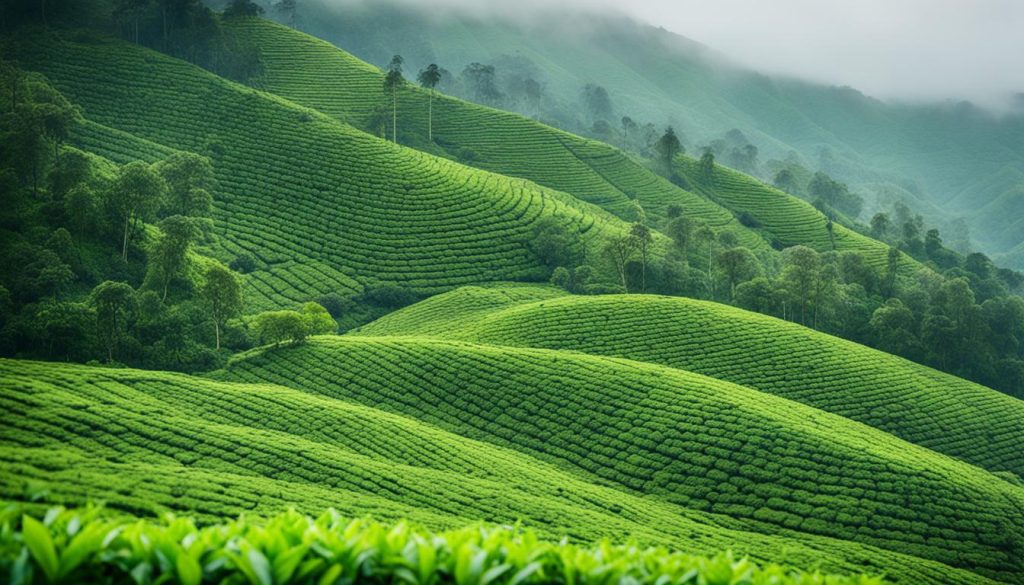
Tea Growing Regions and Their Unique Characteristics
Sri Lanka’s tea country is divided into several regions, each with its unique characteristics that contribute to the aromatic profiles of Ceylon teas. Let’s explore the diverse tea growing regions and their distinct qualities:
Nuwara Eliya Tea
Nuwara Eliya, known as the “Champagne of Ceylon,” produces tea with a light and subtle character, often compared to fine wine. The high altitude, cool climate, and misty conditions create a terroir perfect for delicate tea leaves. Nuwara Eliya teas are prized for their floral aroma and bright, nuanced flavors.
Uva Tea
Uva, with its unique monsoon pattern, produces teas with a brisk, medium-bodied profile and distinct astringency. The combination of high elevation and heavy rainfall brings out the vibrant flavors and lively characteristics of Uva teas. These teas are often favored for their refreshing and invigorating qualities.
Dimbula Tea
Dimbula teas are known for their balanced and robust flavor profiles. With elevations ranging from 3,500 to 6,000 feet, the region experiences cool temperatures, bright sunlight, and ample rainfall. These growing conditions contribute to teas with floral notes, hints of citrus, and a rich, full-bodied taste.
Uda Pussellawa Tea
Uda Pussellawa teas offer a fusion of boldness and briskness. Situated between 3,000 and 5,000 feet above sea level, the region experiences a cool climate and steady rainfall, resulting in teas with a pronounced yet brisk character. Uda Pussellawa teas are known for their unique combination of strength and brightness.
Kandy Tea
Kandy teas are cultivated in the high and mid-elevation landscapes of Sri Lanka. The region’s unique climate, with warm days and cool nights, contributes to teas with rich and full-bodied flavors. Kandy teas often exhibit notes of spice, honey, and maltiness, making them a favorite among tea connoisseurs.
Ruhuna Tea
Ruhuna, located in the southern part of Sri Lanka, produces low-grown teas with a distinctive depth of flavor and earthy undertones. The warm climate and abundant rainfall create teas with a robust character and strong aromas. Ruhuna teas are famous for their full-bodied nature and the unique complexity of their flavor profiles.
Each of these tea growing regions adds its own touch to the world of Ceylon tea, offering a diverse range of flavors and aromas. The altitude, climate, and growing conditions in each region contribute to the distinctive characteristics found in these remarkable teas.
| Tea Growing Region | Altitude | Aromatic Characteristics |
|---|---|---|
| Nuwara Eliya | High altitude | Light and subtle, floral aroma, bright and nuanced flavors |
| Uva | High elevation | Brisk, medium-bodied, vibrant flavors, distinct astringency |
| Dimbula | 3,500 to 6,000 feet | Balanced and robust, floral notes, hints of citrus, rich and full-bodied |
| Uda Pussellawa | 3,000 to 5,000 feet | Bold and brisk, pronounced character, fusion of strength and brightness |
| Kandy | High and mid-elevation | Rich and full-bodied, notes of spice, honey, and maltiness |
| Ruhuna | Low-grown | Distinct depth of flavor, earthy undertones, full-bodied and robust |
The Flavors of Ceylon Tea
Ceylon tea offers a wide range of flavors to suit every palate. From the rich and bold flavors of Black Ceylon Tea to the delicate and refined profile of White Ceylon Tea, there is a Ceylon tea for every tea lover. Let’s explore the diverse flavor profiles of Ceylon tea varieties:
Black Ceylon Tea
Black Ceylon tea is the most popular type of Ceylon tea, known for its rich and robust flavors. The taste varies depending on the region of cultivation, offering a diverse range of aromas and characteristics.
Green Ceylon Tea
Green Ceylon tea possesses a stronger maltiness and full-bodied character compared to green teas from other countries. It offers a unique flavor profile that is distinct to Ceylon tea.
White Ceylon Tea
Considered the highest quality, White Ceylon tea has a delicate and refined profile. It is known for its pine notes and mild sweetness, providing a truly exquisite tea-drinking experience.
Decaf Ceylon Tea
For those who prefer a caffeine-free option, Decaf Ceylon tea is a perfect choice. It offers the same great flavor as regular Ceylon tea, allowing you to enjoy its delicious taste without the stimulation of caffeine.
Ceylon Cinnamon Tea
Ceylon Cinnamon tea is a unique blend of black tea and cinnamon spice. This combination creates a bold and warm flavor that adds a touch of spice to your tea-drinking experience.
Ceylon Oolong Tea
Ceylon Oolong tea is a delightful middle ground between black and green teas. It offers a complex flavor profile with notes of floral, fruity, toasty, and nutty flavors, providing a truly diverse and aromatic tea experience.
Ceylon Flavored Teas
Ceylon flavored teas infuse various ingredients to create unique and delicious flavors. From fruity blends to floral infusions, Ceylon flavored teas offer a wide variety of options for those looking for a delightful twist to their tea.
Limited-Edition Ceylon Teas
For tea connoisseurs seeking something special, limited-edition Ceylon teas are a treasure trove of unique and intriguing flavors. These teas often feature experimental processing methods or are harvested during exceptional periods, resulting in extraordinary flavors and fragrances.
| Tea Type | Flavor Profile |
|---|---|
| Black Ceylon Tea | Rich, bold, and varied depending on region |
| Green Ceylon Tea | Strong maltiness and full-bodied character |
| White Ceylon Tea | Delicate, refined, with pine notes and mild sweetness |
| Decaf Ceylon Tea | Caffeine-free, same great flavor as regular Ceylon tea |
| Ceylon Cinnamon Tea | Bold and warm flavor with cinnamon spice |
| Ceylon Oolong Tea | Floral, fruity, toasty, and nutty notes |
| Ceylon Flavored Teas | Various flavors from fruits to flowers |
| Limited-Edition Ceylon Teas | Experimental flavors and unique harvests |
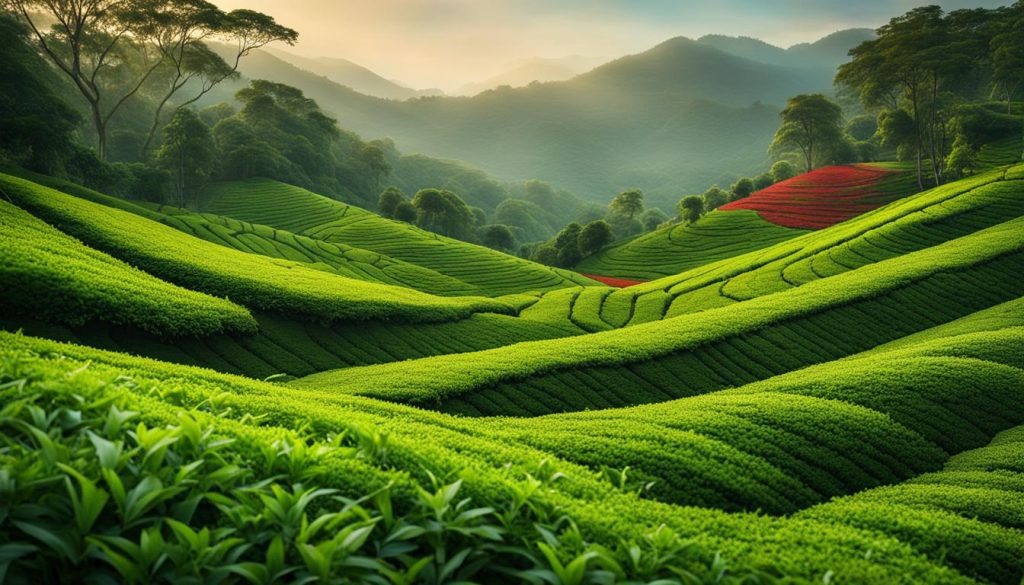
The Art of Brewing Ceylon Tea
Brewing Ceylon tea is an art that can enhance the aromatic experience. To unlock the full flavor potential of your Ceylon tea, it’s important to pay attention to the brewing process. Here are a few key factors to consider:
Proper Water Temperature
The water temperature plays a crucial role in brewing Ceylon tea. Different types of Ceylon teas require specific water temperatures to release their unique flavors. For green tea, a lower temperature of around 175°F is ideal, while black tea can be brewed with water at approximately 200°F.
Tea Leaf Measurement
The amount of tea leaves used in brewing can greatly impact the taste of your Ceylon tea. It’s important to measure the right amount to achieve the desired flavor. As a general guideline, use one teaspoon of loose tea leaves per cup of water.
Steeping Time
Steeping time determines the strength and character of your Ceylon tea. Generally, black teas should be steeped for 3-5 minutes, while green and white teas may require shorter steeping times of 1-3 minutes. Adjust the steeping time to suit your personal preference for taste.
Aromas of Ceylon Tea
Before taking your first sip, take a moment to inhale the delightful aromas of Ceylon tea. The fragrant notes of citrus, floral, or earthy undertones add to the overall tea-drinking experience. Appreciating the aroma enhances your sensory enjoyment of Ceylon tea.
Once your Ceylon tea is brewed to perfection, you can choose to enjoy it plain or enhance the flavor profile. Adding a splash of milk, a dash of sugar, a drizzle of honey, or a squeeze of lemon can bring out different dimensions in the tea’s taste. Experiment with various additions to find your preferred way of enjoying Ceylon tea.
The Heritage of Ceylon Tea
The heritage of Ceylon tea is deeply intertwined with the history and culture of Sri Lanka. The tea industry has had a significant economic impact on our country, playing a crucial role in shaping our identity. The authentic taste and outstanding quality of Pure Ceylon tea are a testament to our rich tea heritage.
Economic Impact of Ceylon Tea
Ceylon tea has been a driving force for economic development in Sri Lanka. The tea industry employs a significant portion of our population and has contributed to the growth of our economy over the years. The export of Ceylon tea generates substantial revenue, making it a vital sector for our country’s financial stability.
Sri Lanka Tea Board and Quality Control
We take great pride in the authenticity and quality of Pure Ceylon tea. The Sri Lanka Tea Board, a regulatory body established in 1976, plays a crucial role in maintaining and promoting the excellence of Ceylon tea. The board sets strict quality standards and oversees the entire tea production process to ensure that consumers receive only the finest and most genuine Ceylon tea.
Authenticity of Pure Ceylon Tea
When you choose Pure Ceylon tea, you can be confident about its authenticity. Every sip reflects our commitment to preserving the heritage and traditions of Ceylon tea. From the lush tea estates of Sri Lanka to your teacup, each cup of Pure Ceylon tea delivers a truly exceptional and genuine tea-drinking experience.
The Heritage of Ceylon Tea – Summary
In summary, the heritage of Ceylon tea encompasses not only its economic impact but also our dedication to maintaining the highest standards of quality and authenticity. Our rich tea heritage has shaped Sri Lanka’s identity as one of the world’s leading producers of exceptional teas. Choose Pure Ceylon tea, indulge in its exquisite flavors, and immerse yourself in the rich heritage of Ceylon tea.
Aromatic Comparison of Ceylon Tea Grades
Ceylon tea offers a wide range of grades, each with its own unique aromatic profile. These grades are determined based on factors such as leaf size, appearance, and overall quality. Let’s explore the different Ceylon tea grades and their distinctive characteristics.
Pekoe: Pekoe is a popular Ceylon tea grade known for its longer, wiry leaves. It offers a delicate and nuanced flavor profile, often with floral and citrusy notes.
Orange Pekoe: Orange Pekoe is another commonly used grade of Ceylon tea. Despite its name, it does not refer to a flavor but rather to the size and appearance of the tea leaves. Orange Pekoe teas typically have larger, whole leaves that produce a smooth and full-bodied brew.
Flowery Orange Pekoe: Flowery Orange Pekoe is a grade of Ceylon tea that features whole leaves with delicate, curled tips. This grade is prized for its aromatic and floral notes, offering a refined and elegant tea-drinking experience.
Broken Orange Pekoe: Broken Orange Pekoe is a grade of Ceylon tea that consists of smaller, broken tea leaves. This grade is known for producing a stronger and bolder brew, ideal for those who prefer a robust cup of tea.
Fannings: Fannings are finely broken tea leaves that result in a quick infusion. This grade is often used in tea bags and offers a strong and flavorful cup of tea.
Dust: Dust is the smallest grade of Ceylon tea, consisting of finely ground tea particles. It is commonly used in tea bags and provides a strong and robust flavor.
By understanding the aromatic profiles of different Ceylon tea grades, you can choose the one that aligns with your flavor preferences and desired brewing experience.
| Tea Grade | Leaf Size | Appearance | Aromatic Profile |
|---|---|---|---|
| Pekoe | Longer, wiry leaves | Whole leaves | Delicate, floral, citrusy |
| Orange Pekoe | Larger, whole leaves | Whole leaves | Smooth, full-bodied |
| Flowery Orange Pekoe | Whole leaves with curled tips | Whole leaves | Aromatic, floral |
| Broken Orange Pekoe | Smaller, broken leaves | Broken leaves | Strong, bold |
| Fannings | Finely broken leaves | Small tea particles | Strong, flavorful |
| Dust | Finely ground particles | Very small tea particles | Strong, robust |
Delighting in the Aromas of Ceylon Tea
Steeping your senses in the aromatic delights of Ceylon tea is a journey that unveils a spectrum of bold and robust profiles, as well as delicate and nuanced flavors. Whether you prefer the invigorating notes of black teas or the subtle elegance of white teas, Ceylon tea offers an array of options to explore and savor.
As we embark on this adventure of exploring aromatic varieties, we are captivated by the rich heritage and exceptional quality that epitomize Ceylon tea. Each cup becomes a moment to cherish, whether it’s a comforting sip to start the day or a rejuvenating break during a hectic afternoon. The robust acidity and full-bodied character of black teas provide a bold and stimulating experience, while the refined and delicate flavors of white teas offer a subtle and indulgent treat.
Ceylon tea has become more than just a beverage; it is a sensory journey that transports us to a world of flavor and sensory delight. With every sip, we immerse ourselves in the distinctive aromas that define each variety, experiencing the interplay of flavors and fragrances. From the earthy undertones of Ruhuna tea to the floral and citrusy notes of Nuwara Eliya tea, every cup holds a story waiting to be discovered.
So, when you find yourself in need of a moment of tranquility or an escape into the world of flavors, reach for a cup of Ceylon tea. Let its aromatic profiles awaken your senses and elevate your tea-drinking moments to new heights. Indulge in the bold, robust, delicate, and nuanced flavors that Ceylon tea has to offer, as you embark on a journey of delightful aromas and unforgettable tea experiences.
